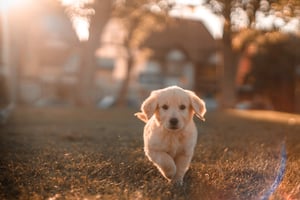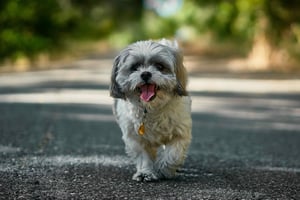Potty training your puppy can be a challenging task, especially when it comes to crate training....
Dog Potty Training: Everything You Need To Know
Your puppy or dog potty training needs more than you can think of. The crucial thing about potty training is to give your dog love and some time to get the hang of this idea.
How to Potty Train an Adult Dog
Adult dog potty training is the same as puppy training, but there are some do's and don'ts that you should follow during the training process.
Do's of Potty Training an Adult Dog
-
Set a schedule
-
Limit their space while potty training
-
Use positive reinforcement
-
Learn to recognize cues when they need to go out
-
Walk them on a leash
Don'ts of Potty Training an Adult Dog
-
Mixing puppy pads with crate
-
Using punishment
-
Keeping inconsistent schedules
How to Potty Train a Puppy
The training starts from the schedule and requires patience, love, and positive reinforcement. Consult your vet for any health issue in the puppy and follow the instructions mentioned below.
Do's of Potty Training a Puppy
-
Take the puppy out more often
-
Stick to a feeding schedule
-
Use positive reinforcement
-
Learn to recognize puppy needs to go out
-
Put the puppy on a leash for potty breaks
Don'ts of Potty Training a Puppy
-
Mixing potty pads with crate training
-
Using punishment
-
Not following a schedule
10 Puppy and Dog Potty Training Tips
The following tips will help you with the training process and will make it more effective and enjoyable.
-
Stick to the schedule. The key principle here is consistency and remaining stick to the schedule, be aware that there is no holiday in the beginning.
-
Understand their needs. When you want to train them, you need to learn their pee and potty cues, and by spending time with them, you can have that with ease.
-
Take them out after every meal and snack. This is especially useful for puppies as they need to go out more often; it will help you train them to a particular place for poop and pee.
-
Reward positive actions. Dogs cannot fathom punishment, but they can relate to positive reinforcement and rewards, appreciate them more frequently to teach them faster.
-
Place a bell on your door. The bell on the door will work as a conditioning device to motivate them to get out as Pavlov (behavioural psychologist) used to managed a dog's behaviour.
-
Eliminate all the odours. When there has been an accident, thoroughly remove all the odours from the place to avoid further unwarranted incidents in the same place.
-
Always use the same spot. Make it a routine and habit for them to do business in the exact place; this will make them learn faster for where to poop.
-
Try a puppy pad. Puppies are difficult to manage in the beginning, and the use of a puppy pad is a less messy and more convenient training hack.
-
Use prompts. Using specific words will make the conditioning more convenient for them to initiate the process in the place of your choice.
-
Take them out before you greet them. When you reach home, the first thing should be to take them out to the designated potty place to make them realize the importance of this ritual.
Puppy training methods
Here are some of the best puppy training methods:
-
Tethering: when you tie your dog or puppy to a particular place with the help of a leash. The whole process becomes easier, and you can let them loose afterwards to make them come to the very spot for potty.
-
Confinement: Confine your dog or puppy in a particular area with the help of a moveable fence. This will help you let them come out and play when they have done the dirty business.
-
Outdoor: offer your dog liberty when you have access to a garden, backyard, or some open place around your house. This is the best you can offer to your dog. The puppy and dog will love this idea and will learn soon.
Tips to Speed up Potty Training Process
You can use the following tips to speed up the process effectively:
-
Learn the basics about the breed of your dog with detailed behavioural information.
-
Understand the behavioural needs of your dog or puppy.
-
Keep an eye on them for cues and signs of the time they need to do business.
-
Use forbidding words to interrupt the accident right away and clean thoroughly to eliminate odour.
-
Choose a potty zone and make your puppy or dog do the business in the right place.
-
Praise their success with treats and good words, patting and hugging.
-
Make potty time a fun activity for your dog.
Potty Training FAQs
Q: Why is there regression in dog potty training?
A: The main reasons behind the regression are the changes in eating schedules, walking routines, or habits. When the dog is not feeling right or has a health issue, you will also see the changed behaviour. If there is no change in your schedule and there is no variation in anything at home, consult the vet right away.
Q: Are dog potty training sprays useful?
A: When you spray the chemicals, the odour will help your dog locate the area and get them motivated to do the business. These sprays are useful and effective for the puppy and dog potty training process.
Q: What is the best age for dog potty training?
A: The maximum age is nine months for the dog to learn the process. The training will be completed in the first few months for some puppies, and the other might take more time. The answer to this question is breed-specific. As a pet parent, potty training is one of the first things you'll face before you can start thinking about tricks to teach your dog.
Puppies and Dog Potty Training Problems
The crucial thing here is to know about their health condition. The most common dog potty training problems are as follow:
-
Piddling dog. This is the most common phenomenon when the dog or a puppy piddles all over the place. The toy breeds are more notorious for this behaviour. The solution to this problem is crate training, additional time, and some extra efforts
-
Consecutive pee-ing on the wrong place. Well, here you are to blame for this bad behaviour of your dog. When doing dog potty training, you must eliminate the odour by cleaning the place right away.
-
Crate soiling. When your dog is soiling crate, it is because of the long confinement in the enclosed space. Give extra time in the outdoor and open-air to your dog with positive reinforcement. Do consider the following:
-
Assess bladder and bowel control
-
Control diet and schedule
-
Give frequent trips outside
-
Consider a dog walker
-
Clean odours right away of the accident
-
Dog Potty Training Tenure
The time for the puppy and dog potty training can vary because of the various factors involved. Some puppies can show perfect manners after a few days. Whereas, for some puppies, it might take weeks or months to make them accustomed to doing potty at the designated place. For adult dogs, the owner's learning history and consistency are the two most significant factors. Both for puppies and dogs, the best tools are patience and positive reinforcement. With consistent love and treats, you can make them do potty in the place where you want them to do.



